After five days of wild, news-driven swings in the stock market, where the action was dominated by escalating trade tensions, the threat of a currency war, and the possibility that the next U.S.-China meeting scheduled for September may not happen, investors can't be blamed for starting the week with some questions. Not the least of which is if the trade war/currency spat could push the world economies into recession - and wind up dragging he U.S. down with them.
On that front, it wasn't at all encouraging to see the UK's economy shrink last quarter. Or the recent German Industrial Production report, which registered the largest annual decline in almost a decade. Or the fact that the OECD's US Composite Leading Indicator fell again in June to the lowest reading since 2009 (Source: Ned Davis Research) and registered its 14th straight monthly decline in the process. Or Goldman's weekend reduction in their outlook for U.S. GDP.
Next on the list of head-scratchers is last week's action by the Central Bankers, which, at the very least, seems to suggest that there is some concern out there.
For example, New Zealand surprised investors with a 50 basis point cut last week, which was twice what economists had expected. India's central bank lowered its rate by an unusual 35 basis points. The Philippine central bank cut on Thursday. And Thailand surprised market participants by cutting their benchmark rate by 25 basis points. This after Jay Powell & Co cut here in the U.S. and Super Mario promised the he and his successor, Christine Lagarde, will soon take action on behalf of the ECB.
One and Done? Not Exactly
Here at home, Fed officials are starting to suggest that more action may need to be taken. According to the WSJ, Chicago President Charles Evans said trade and other global developments "have perhaps created more headwinds... and it would be reasonable to do more."
Look At Those Bonds!
And then there is the action in the global bond market. Apparently this little "skirmish" between the U.S. and China, which has been going on for more than a year and a half now, is creating what is referred to as a "flight to quality." Or, maybe more appropriately in this case, a flight to your local government's bond market.
How else does one explain the yield on Portugal's 10-year at 0.16%? Or Ireland's 10-year dipping below zero, or Spain's 10-year at 0.13%? (And lest we forget, these three countries were all part of the infamous "PIIGS" that were responsible for much of the European debt crises a few years back.)
Looking at more stable economic environs, the yield on Germany's 10-year bund is trading at -0.594% this morning. France's yield hit -0.35% last week. Japan's 10-year is -0.221% today. And for those of you keeping score at home, Deutsche Bank tells us that the total amount of government bonds now trading with negative yields around the globe has ballooned to $15 trillion, which is about double the amount seen last fall.
Here in the U.S., the yield on the 10-year has plunged 1.56% since October (which is a decline of a cool 48.2%). Oh, and the yield curve is inverted. Super.
The "message" being taken from all of this is the global bond markets are screaming for attention. That something is wrong. And that the game is going to end badly for investors, ala a 2008-style collapse. Or so say our furry friends in the bear camp.
Those seeing the investing landscape's glass as at least half empty contend that the U.S. stock market has lost touch with reality and has no justification for the current levels. Ugh.
Maybe Don't Jump on the Doom & Gloom Train Just Yet
But before you run out and starting digging a hole in the back yard to bury your cash in or start loading up on those inverse ETFs, I'd like to offer up a at least a couple alternative scenarios regarding the current "message" from the bond market.
There can be no denying that an inverted yield curve and plunging yields should get your attention. However, I'm of the mind that old fashioned "money flows" are also at work here - in a pretty big way.
First of all, consider that we invest in a global world now. So, we have to think about the financial system on a global scale. And the bottom line is that I, for one, see a global chase for yields going on. Remember, money tends to go where it is treated best - especially during times of stress, fear, and/or crisis.
While I don't believe the current trade war has created a crisis state, it is pretty obvious that there is some "flight to safety" happening here. So, if you are a global investor, where do you stash your money? In Germany, with a guaranteed annual loss of 0.6% or the U.S. 10-year at 1.66%. Not much of a decision, right?
Shaking Hands With The Government
Next up is the old bond trading play, which suggest that when central bankers are easing or playing the QE game, it pays to "shake hands with the government."
From my seat, this helps "esplain" at least a portion of the explosion in negative yields around the globe. For example, if the ECB cranks up the QE machine again, investors know there is going to be a buyer of bonds every month - for quite some time. Thus, you want to get in before the central bankers start buying. So, if you bought bonds with a yield of -0.4%, the ongoing demand for the bonds means yields will likely go lower still. And as such, you can expect a gain on your position. As long as somebody with deep pockets has to buy, it is relatively safe to buy here. Crazy, yes. But so goes the game of musical chairs in the bond market.
Forced Buying
Speaking of forced buying, let's also keep in mind that not too long ago, one of the no-brainer macro trades was to short bonds. Remember, yields were going to go higher in the U.S. - perhaps a lot higher. If memory serves, there calls for a 5% T-Bond yield.
And what happens to a short position when prices fall nearly 50%? That's right, margin calls. Forced liquidations. And fund blow-ups. All of which create the buying of bonds.
Although we haven't heard any specific names abruptly closing their doors, it is a pretty safe bet that "forced selling" (or in this case, forced buying to cover short bond positions) has been at work here. This is just what happens when a "no-brainer" macro call goes the wrong way, in a big way.
Then There's TINA
And finally, let's consider the idea of TINA - as in "there is no alternative." Let's keep in mind that if you are a big pension plan or an insurance company, your options regarding what you can invest in are limited. As a manager, you are forced to put money into instruments that might seem overvalued. But, since you really don't have a choice, you just keep buying when new money comes in.
In closing, my primary point on this fine summer morning is that the "message" from the bond market may not be quite as bad as the doom-and-gloomers contend. And while there can be no argument that the action in global bonds is a little nutty right now, something big is going to have to happen to change the current game.
And no, I do not know how this game ends. But for now at least, it is probably best to follow the money and keep your eyes and ears open.
Weekly Market Model Review
Now let's turn to the weekly review of my favorite indicators and market models...
The State of My Favorite Big-Picture Market Models
It was a wild ride on Wall Street last week as we started with the biggest down day of the year and then enjoyed an impressive rebound Wednesday and Thursday. Through it all there wasn't any change to our Primary Cycle models as the board remains in pretty good shape. As I've been saying, the readings of the Primary Cycle and Fundamental boards suggests that investors should treat pullbacks as buying opportunities.
This week's mean percentage score of my 6 favorite models improved to 71.1% from 70.3%% last week (Prior readings: 84.1%, 79%, 83.9%, 81.1%, 73.5%, 62.9%) while the median also upticked to 70.0% versus 68.4% last week (Prior readings: 86.5%, 80%, 86.7%, 82.5%, 68.5%, 66.3%, 71.3%).
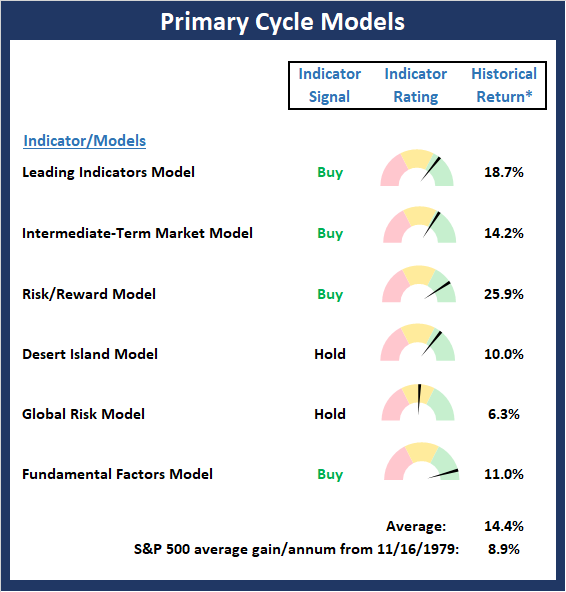
* Source: Ned Davis Research (NDR) as of the date of publication. Historical returns are hypothetical average annual performances calculated by NDR. Past performances do not guarantee future results or profitability - NOT INDIVIDUAL INVESTMENT ADVICE.
View My Favorite Market Models Online
The State of the Fundamental Backdrop
Despite all the market hysterics seen over the past two weeks, there has been no change to the Fundamental board. The bottom line is the big-picture, fundamental backdrop remains positive with historical returns that are above average.
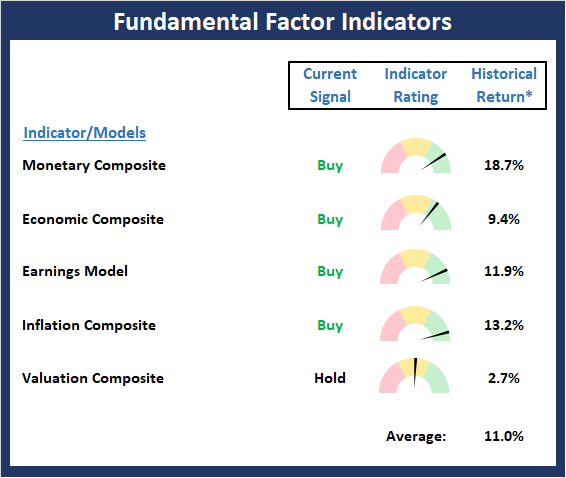
* Source: Ned Davis Research (NDR) as of the date of publication. Historical returns are hypothetical average annual performances calculated by NDR. Past performances do not guarantee future results or profitability - NOT INDIVIDUAL INVESTMENT ADVICE.
View Fundamental Indicator Board Online
The State of the Trend
Although the headlines tout extreme volatility and fear, our Price Trend board actually improved last week. This is in response to the Short-Term Trend signal perking up, the S.T. Channel Breakout System flashing a buy on Wednesday, and the Cycle Composite pointing higher next week. However, my best guess is we're seeing a bottoming process play out, which means a test of the recent lows is more likely than not. But, I for one, will be looking to add to positions into any further weakness.
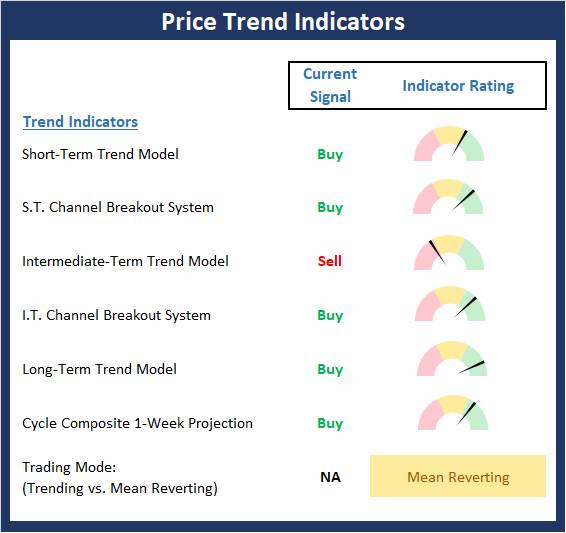
NOT INDIVIDUAL INVESTMENT ADVICE.
View Trend Indicator Board Online
The State of Internal Momentum
If you are looking for reasons to be be cautious on the stock market, the Momentum board is it. While the Short-Term Trend & Breadth Confirm model upticked within the neutral zone last week, the Intermediate-Term model went the other way. In addition, the L.T. Volume Relationship model is sagging and all three Thrust indicators are solidly negative. The good news is that the bulls can rally, most of these ills can be remedied in short order. But for now, this board gives the bear camp the edge in the near-term.
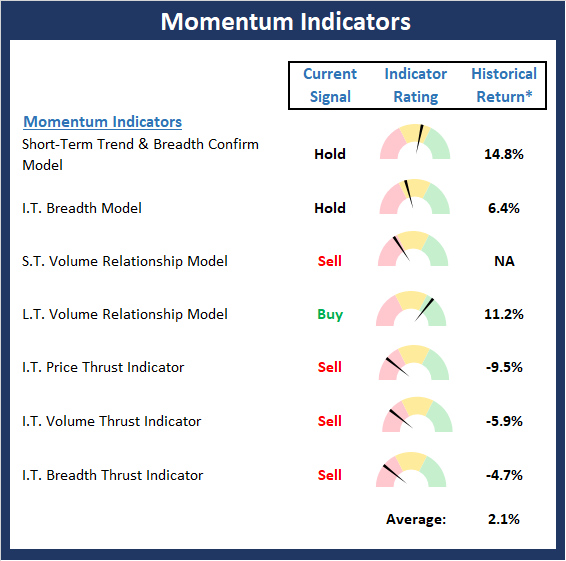
* Source: Ned Davis Research (NDR) as of the date of publication. Historical returns are hypothetical average annual performances calculated by NDR. Past performances do not guarantee future results or profitability - NOT INDIVIDUAL INVESTMENT ADVICE.
View Momentum Indicator Board Online
The State of the "Trade"
While I would not classify the current state of the Early Warning Board as a "table pounding" setup, it is clear that the wind is now blowing at the bulls' back. So, unless the bears can push the indices to new lows, we would view any downside testing as an opportunity - especially if the declines are "bought" intraday over a period of a few days.
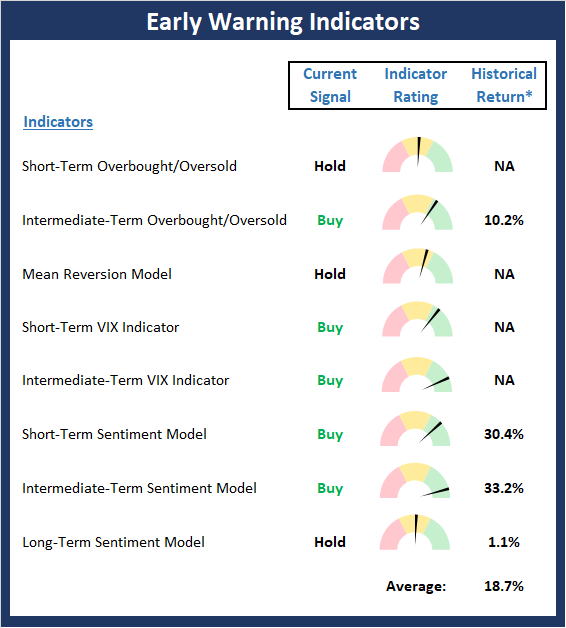
* Source: Ned Davis Research (NDR) as of the date of publication. Historical returns are hypothetical average annual performances calculated by NDR. Past performances do not guarantee future results or profitability - NOT INDIVIDUAL INVESTMENT ADVICE.
View Early Warning Indicator Board Online
Thought For The Day:
Between saying and doing many a pair of shoes is worn out. --Italian proverb
Wishing you green screens and all the best for a great day,

David D. Moenning
Founder, Chief Investment Officer
Heritage Capital Research
HCR Focuses on a Risk-Managed Approach to Investing
What Risk Management Can and Cannot Do
Disclosures
At the time of publication, Mr. Moenning held long positions in the following securities mentioned: None - Note that positions may change at any time.
Leading Indicators Model: A group of indicators that have historically shown tendencies to lead the market at major turning points.
Intermediate-Term Market Model: A composite model (model of models) focused on trend and momentum indicators which has been designed to provide identify intermediate-term trading opportunities.
Risk/Reward Model: A model-of-models intended to provide an overall view of the state of the risk/reward environment. The model includes tape, monetary, and sentiment indicators as well as 7 big-picture market model readings.
Desert Island Model: If I was stranded on a desert island with access to only one market model to manage money with, this would be the model. The model is a comprehensive model-of-models comprised of trend, momentum, mean reversion, economic, monetary, sentiment, and factor-based indicators/models.
External Factors Model: A model-of-models designed to provide a reading on the "macro state" of the market environment. The model is comprised of indicators/models in the areas of various index yields, industrial production, investors sentiment, and historic volatility.
Short-Term Trend-and-Breadth Signal Explained: History shows the most reliable market moves tend to occur when the breadth indices are in gear with the major market averages. When the breadth measures diverge, investors should take note that a trend reversal may be at hand. This indicator incorporates NDR's All-Cap Dollar Weighted Equity Series and A/D Line. From 1998, when the A/D line is above its 5-day smoothing and the All-Cap Equal Weighted Equity Series is above its 25-day smoothing, the equity index has gained at a rate of +32.5% per year. When one of the indicators is above its smoothing, the equity index has gained at a rate of +13.3% per year. And when both are below, the equity index has lost +23.6% per year.
Channel Breakout System Explained: The short-term and intermediate-term Channel Breakout Systems are modified versions of the Donchian Channel indicator. According to Wikipedia, "The Donchian channel is an indicator used in market trading developed by Richard Donchian. It is formed by taking the highest high and the lowest low of the last n periods. The area between the high and the low is the channel for the period chosen."
Intermediate-Term Trend-and-Breadth Signal Explained: This indicator incorporates NDR's All-Cap Dollar Weighted Equity Series and A/D Line. From 1998, when the A/D line is above its 45-day smoothing and the All-Cap Equal Weighted Equity Series is above its 45-day smoothing, the equity index has gained at a rate of +17.6% per year. When one of the indicators is above its smoothing, the equity index has gained at a rate of +6.5% per year. And when both are below, the equity index has lost -1.3% per year.
Cycle Composite Projections: The cycle composite combines the 1-year Seasonal, 4-year Presidential, and 10-year Decennial cycles. The indicator reading shown uses the cycle projection for the upcoming week.
Trading Mode Indicator: This indicator attempts to identify whether the current trading environment is "trending" or "mean reverting." The indicator takes the composite reading of the Efficiency Ratio, the Average Correlation Coefficient, and Trend Strength models.
Volume Relationship Models: These models review the relationship between "supply" and "demand" volume over the short- and intermediate-term time frames.
Price Thrust Model Explained: This indicator measures the 3-day rate of change of the Value Line Composite relative to the standard deviation of the 30-day average. When the Value Line's 3-day rate of change have moved above 0.5 standard deviation of the 30-day average ROC, a "thrust" occurs and since 2000, the Value Line Composite has gained ground at a rate of +20.6% per year. When the indicator is below 0.5 standard deviation of the 30-day, the Value Line has lost ground at a rate of -10.0% per year. And when neutral, the Value Line has gained at a rate of +5.9% per year.
Volume Thrust Model Explained: This indicator uses NASDAQ volume data to indicate bullish and bearish conditions for the NASDAQ Composite Index. The indicator plots the ratio of the 10-day total of NASDAQ daily advancing volume (i.e., the total volume traded in stocks which rose in price each day) to the 10-day total of daily declining volume (volume traded in stocks which fell each day). This ratio indicates when advancing stocks are attracting the majority of the volume (readings above 1.0) and when declining stocks are seeing the heaviest trading (readings below 1.0). This indicator thus supports the case that a rising market supported by heavier volume in the advancing issues tends to be the most bullish condition, while a declining market with downside volume dominating confirms bearish conditions. When in a positive mode, the NASDAQ Composite has gained at a rate of +38.3% per year, When neutral, the NASDAQ has gained at a rate of +13.3% per year. And when negative, the NASDAQ has lost at a rate of -14.279% per year.
Breadth Thrust Model Explained: This indicator uses the number of NASDAQ-listed stocks advancing and declining to indicate bullish or bearish breadth conditions for the NASDAQ Composite. The indicator plots the ratio of the 10-day total of the number of stocks rising on the NASDAQ each day to the 10-day total of the number of stocks declining each day. Using 10-day totals smooths the random daily fluctuations and gives indications on an intermediate-term basis. As expected, the NASDAQ Composite performs much better when the 10-day A/D ratio is high (strong breadth) and worse when the indicator is in its lower mode (weak breadth). The most bullish conditions for the NASDAQ when the 10-day A/D indicator is not only high, but has recently posted an extreme high reading and thus indicated a thrust of upside momentum. Bearish conditions are confirmed when the indicator is low and has recently signaled a downside breadth thrust. In positive mode, the NASDAQ has gained at a rate of +22.1% per year since 1981. In a neutral mode, the NASDAQ has gained at a rate of +14.5% per year. And when in a negative mode, the NASDAQ has lost at a rate of -6.4% per year.
Short-Term Overbought/sold Indicator: This indicator is the current reading of the 14,1,3 stochastic oscillator. When the oscillator is above 80 and the %K is above the %D, the indicator gives an overbought reading. Conversely, when the oscillator is below 20 and %K is below its %D, the indicator is oversold.
Intermediate-Term Overbought/sold Indicator: This indicator is a 40-day RSI reading. When above 57.5, the indicator is considered overbought and wnen below 45 it is oversold.
Mean Reversion Model: This is a diffusion model consisting of five indicators that can produce buy and sell signals based on overbought/sold conditions.
VIX Indicator: This indicators looks at the current reading of the VIX relative to standard deviation bands. When the indicator reaches an extreme reading in either direction, it is an indication that a market trend could reverse in the near-term.
Short-Term Sentiment Indicator: This is a model-of-models composed of 18 independent sentiment indicators designed to indicate when market sentiment has reached an extreme from a short-term perspective. Historical analysis indicates that the stock market's best gains come after an environment has become extremely negative from a sentiment standpoint. Conversely, when sentiment becomes extremely positive, market returns have been subpar.
Intermediate-Term Sentiment Indicator: This is a model-of-models composed of 7 independent sentiment indicators designed to indicate when market sentiment has reached an extreme from a intermediate-term perspective. Historical analysis indicates that the stock market's best gains come after an environment has become extremely negative from a sentiment standpoint. Conversely, when sentiment becomes extremely positive, market returns have been subpar.
Long-Term Sentiment Indicator: This is a model-of-models composed of 6 independent sentiment indicators designed to indicate when market sentiment has reached an extreme from a long-term perspective. Historical analysis indicates that the stock market's best gains come after an environment has become extremely negative from a sentiment standpoint. Conversely, when sentiment becomes extremely positive, market returns have been subpar.
Absolute Monetary Model Explained: The popular cliche, "Don't fight the Fed" is really a testament to the profound impact that interest rates and Fed policy have on the market. It is a proven fact that monetary conditions are one of the most powerful influences on the direction of stock prices. The Absolute Monetary Model looks at the current level of interest rates relative to historical levels and Fed policy.
Relative Monetary Model Explained: The "relative" monetary model looks at monetary indicators relative to recent levels as well as rates of change and Fed Policy.
Economic Model Explained: During the middle of bull and bear markets, understanding the overall health of the economy and how it impacts the stock market is one of the few truly logical aspects of the stock market. When our Economic model sports a "positive" reading, history (beginning in 1965) shows that stocks enjoy returns in excess of 21% per year. Yet, when the model's reading falls into the "negative" zone, the S&P has lost nearly -25% per year. However, it is vital to understand that there are times when good economic news is actually bad for stocks and vice versa. Thus, the Economic model can help investors stay in tune with where we are in the overall economic cycle.
Inflation Model Explained: They say that "the tape tells all." However, one of the best "big picture" indicators of what the market is expected to do next is inflation. Simply put, since 1962, when the model indicates that inflationary pressures are strong, stocks have lost ground. Yet, when inflationary pressures are low, the S&P 500 has gained ground at a rate in excess of 13%. The bottom line is inflation is one of the primary drivers of stock market returns.
Valuation Model Explained: If you want to get analysts really riled up, you need only to begin a discussion of market valuation. While the question of whether stocks are overvalued or undervalued appears to be a simple one, the subject is actually extremely complex. To simplify the subject dramatically, investors must first determine if they should focus on relative valuation (which include the current level of interest rates) or absolute valuation measures (the more traditional readings of Price/Earnings, Price/Dividend, and Price/Book Value). We believe that it is important to recognize that environments change. And as such, the market's focus and corresponding view of valuations are likely to change as well. Thus, we depend on our Valuation Models to help us keep our eye on the ball.
Disclosures
NOT INVESTMENT ADVICE. The opinions and forecasts expressed herein are those of Mr. David Moenning and Heritage Capital Research and may not actually come to pass. The opinions and viewpoints regarding the future of the markets should not be construed as recommendations. The analysis and information in this report is for informational purposes only. No part of the material presented in this report is intended as an investment recommendation or investment advice. Neither the information nor any opinion expressed constitutes a solicitation to purchase or sell securities or any investment program.
Any investment decisions must in all cases be made by the reader or by his or her investment adviser. Do NOT ever purchase any security without doing sufficient research. There is no guarantee that the investment objectives outlined will actually come to pass. All opinions expressed herein are subject to change without notice. Neither the editor, employees, nor any of their affiliates shall have any liability for any loss sustained by anyone who has relied on the information provided.
Mr. Moenning of Heritage Capital Research is an investment adviser representative of Eastsound Capital Advisors, LLC, a registered investment advisor. The adviser may not transact business in states where it is not appropriately registered, excluded or exempted from registration. Individualized responses to persons that involve either the effecting of transaction in securities, or the rendering of personalized investment advice for compensation, will not be made without registration or exemption.
Mr. Moenning and Heritage Capital Research may at times have positions in the securities referred to and may make purchases or sales of these securities while publications are in circulation. Positions may change at any time.
The analysis provided is based on both technical and fundamental research and is provided "as is" without warranty of any kind, either expressed or implied. Although the information contained is derived from sources which are believed to be reliable, they cannot be guaranteed.
The author neither endorses nor warrants the content of this site, any embedded advertisement, or any linked resource. The author or his managed funds may hold either long or short positions in the referenced securities. Republication rights must be expressly granted by author in writing.
Investments in equities carry an inherent element of risk including the potential for significant loss of principal. Past performance is not an indication of future results.

